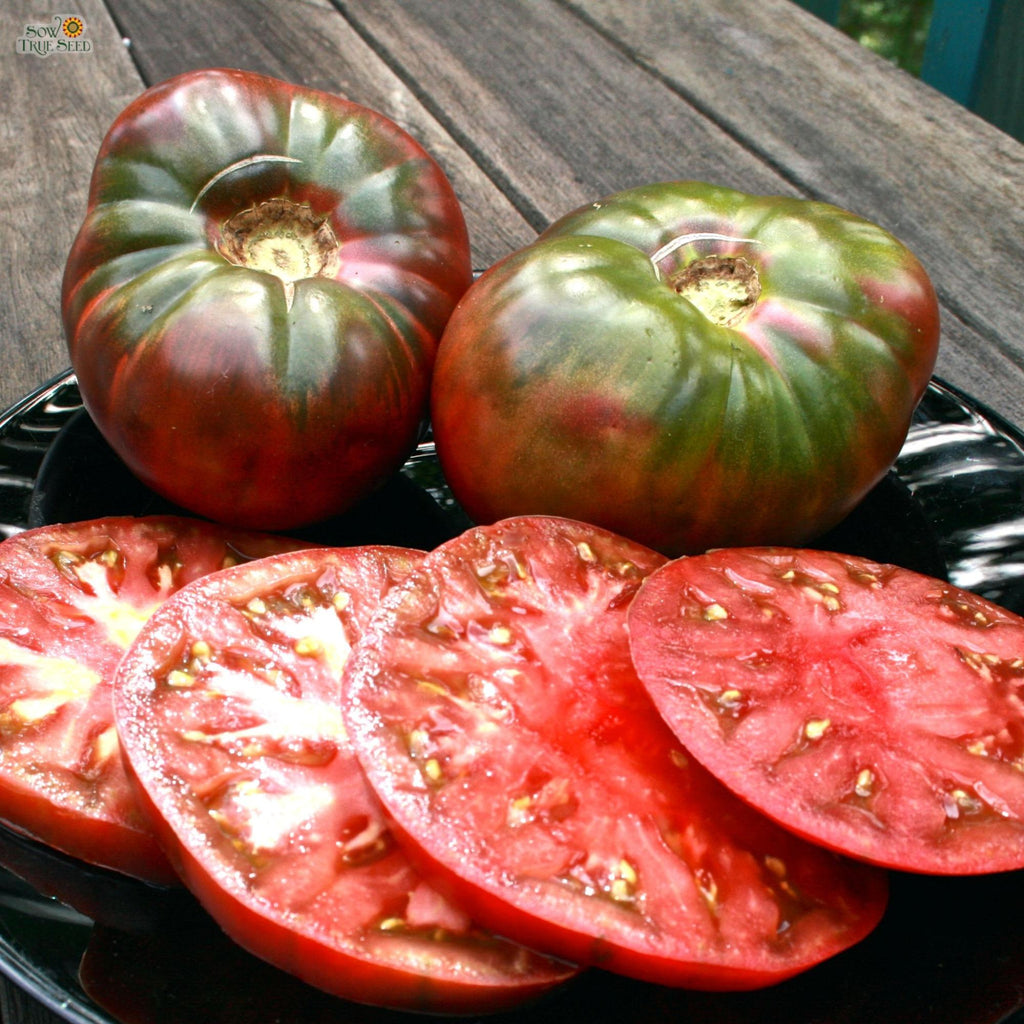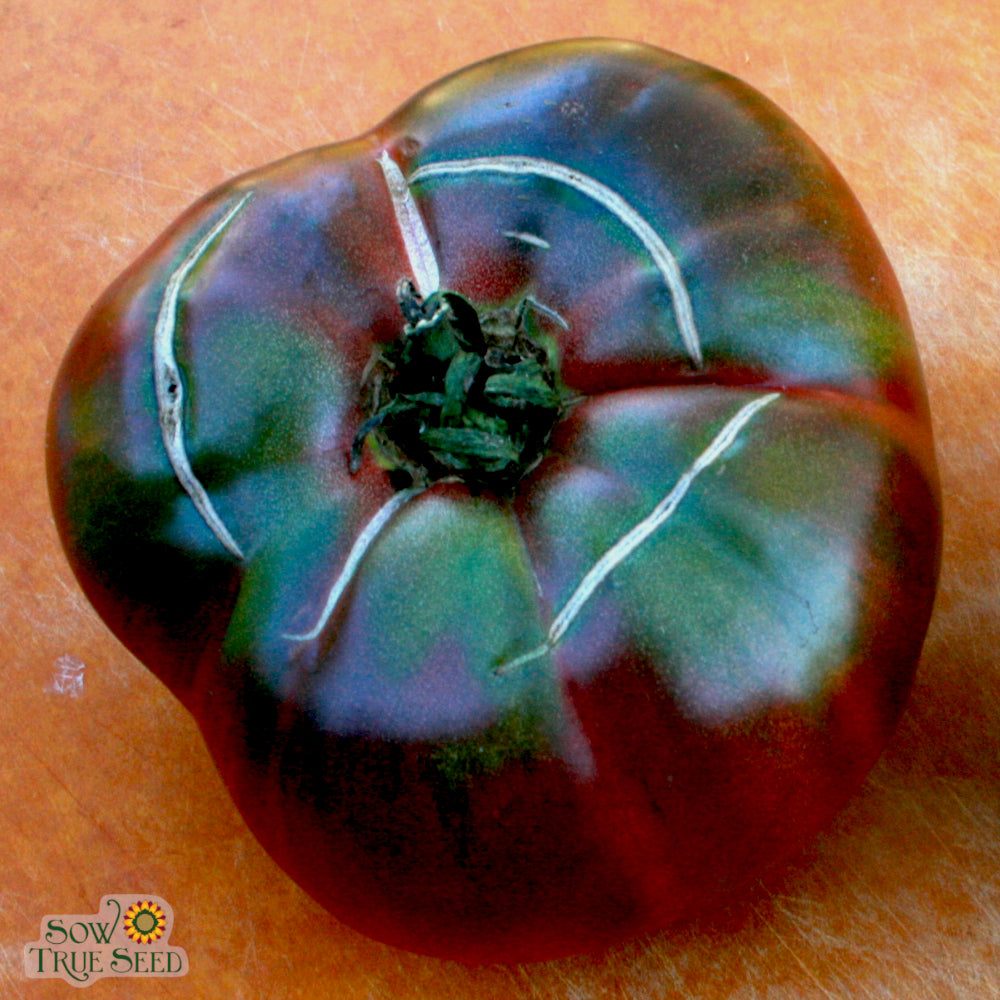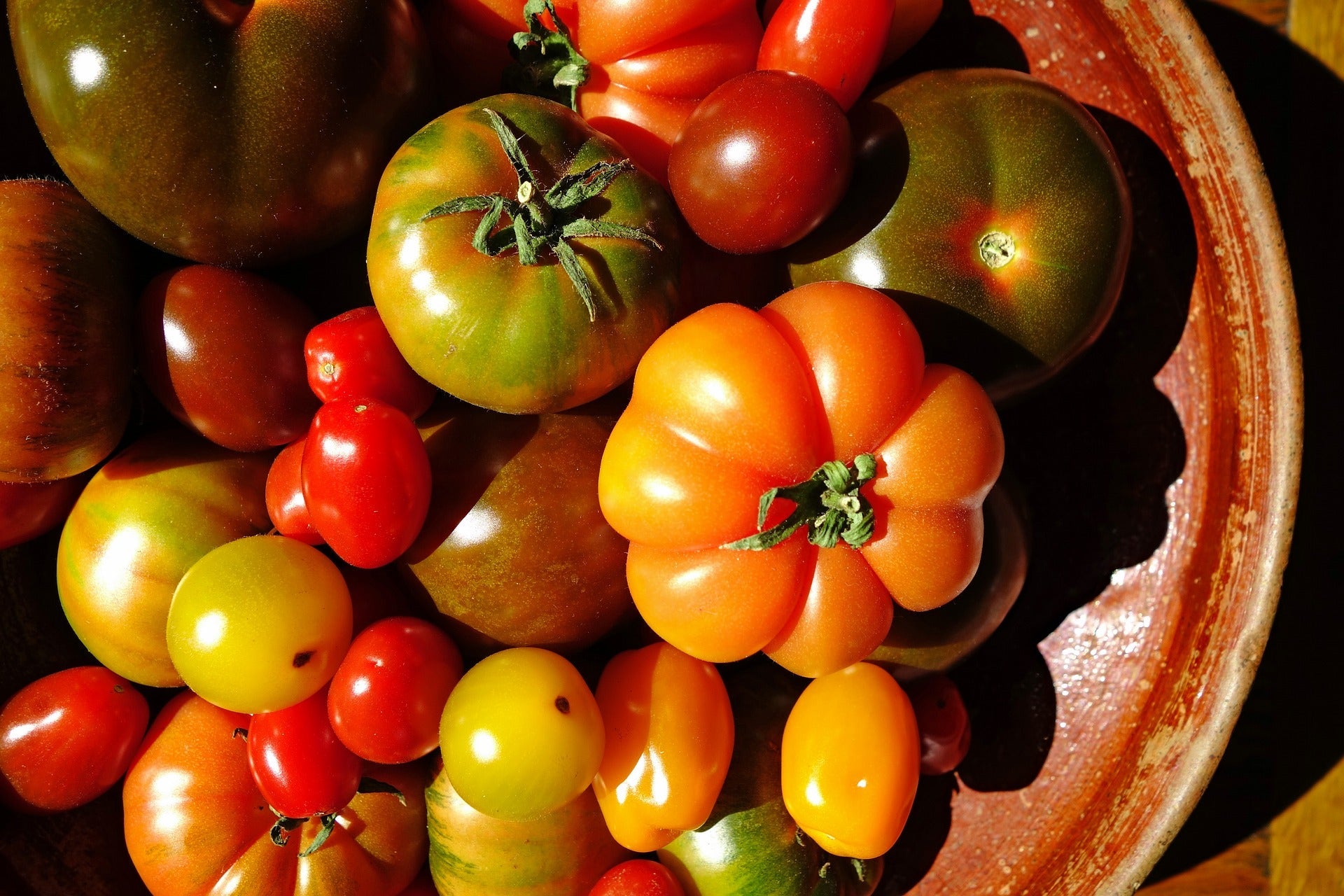Many people grow tomatoes from starts purchased at a hardware store or nursery, which is great for convenience, but gives you only a few varieties to pick from. One good reason to graduate to growing your tomatoes from seed is to have access to many more interesting varieties. In fact, opening up a seed catalog to choose tomato seeds can be almost overwhelming! Tomatoes are one of the most diverse vegetable crops out there. They come in seemingly endless shapes, sizes, and colors, and there are different varieties adapted to just about every climate and culinary use. Here’s a guide to the many kinds of tomatoes, and how to choose the best varieties for your garden.
Types of Tomatoes
The first thing to ask yourself when choosing what varieties of tomatoes to grow in your garden is, how do I want to eat them? Here are the three broad categories we use to describe the types of tomatoes, based on how they’re used.

Slicing Tomatoes
Slicing tomatoes are big and round or flattened-round (aka “oblate,” if you want to impress your gardener friends) and perfect for making thick slices for burgers or sandwiches. Some slicers are described as “beefsteak” type, meaning they are especially big and meaty.

Paste Tomatoes
Paste or sauce tomatoes are characterized by rich flavor, thick fruit walls, and very small seed cavities, which help them cook down into tomato paste or homemade sauce quicker than bigger, juicier varieties. They are also great for canning in general, whole or chopped, and their relatively low moisture content makes them ideal for dried tomatoes as well. Some paste tomatoes might also be pretty good for fresh eating, but their highest calling is as a cooking ingredient.

Cherry Tomatoes
Cherry tomato varieties produce small, juicy fruits that grow in clusters, and are perfect for snacking, salads, or to use in veggie kebabs on the grill. There’s a special little joy in popping a sun-warmed, perfectly ripe cherry tomato in your mouth while working in the garden on a summer day.

Determinate vs. Indeterminate
You’ll notice that all tomato variety descriptions will note that the variety is either determinate or indeterminate. “Determinate” means that the plants will grow to a certain size, set a lot of fruits at once, ripen them all at about the same time, then stop producing. “Indeterminate” means the plants will continually grow, flower, and set fruits a few at a time throughout the season, until frost or blight stops them. Most paste tomatoes are determinate, since you want a lot of ripe fruit at once to make it worth your trouble to can them or make sauce. Many dwarf tomatoes for container growing also behave more like determinate types. The majority of the slicing and cherry tomatoes that Sow True Seed carries are indeterminate. There are determinate slicers and cherry tomatoes out there, but they tend to be favored more by commercial producers than home gardeners, who mostly prefer a gradual harvest throughout the summer to a ton of tomatoes at once.
Popular Kinds of Tomatoes
Now you know a little more about how to choose the right tomatoes for your garden. “But there’s still so many to choose from, how do I pick!?” you say. Here’s a guide to some all-time favorite varieties of all different shapes, sizes, colors and types.

Heirloom Tomatoes
Heirloom tomatoes are what many gardeners are after, because of their storied reputation for excellent flavor. An “heirloom” vegetable is any variety that has been passed down generation to generation. Most originated before the second World War, and many are much older than that. If a variety has been saved and passed down for that long, you know it tastes good, and many of these have great stories to go along with their culinary quality. Plus, many have quirky shapes and colors you’d never see at a grocery store. About half the tomatoes we offer at Sow True Seed are heirlooms! Browse all of our heirloom tomatoes, or check out these gems you might not have heard of:
Unusual Heirloom Tomato Varieties
- Oaxacan Pink - Medium-sized, ribbed fruits with a gorgeous pink hue.
- Chocolate Stripes - Dark green stripes on maroon, medium-sized fruit.
- Paul Robeson - Delicious round slicers with a purple blush on the shoulders.

Beefsteak Tomatoes
“Beefsteak tomato” is basically synonymous with “amazing sandwich.” These hefty slicing tomatoes are the biggest and meatiest around, so satisfying to pick and enjoy.
Varieties of Beefsteak Tomatoes
- Pink Brandywine - A legendary heirloom tomato!
- Cherokee Purple - Sow True’s all-time bestselling tomato variety.
- Mortgage Lifter - Incredible 1-2 lb fruits are common on this variety.

Green Tomatoes
Not unripe green tomatoes like you use for fried green tomatoes - tomatoes that stay green when they’re sweet and ripe! These unusual varieties are especially great to grow at home, because you usually won’t find them in the grocery store. (Not that you’re going back to grocery store tomatoes once you’ve seen the light of the home-grown kind anyway.)
Varieties of Green Tomatoes
- Aunt Ruby’s German Green- An heirloom large, green slicer.
- Green Doctors - A green cherry named for tomato experts Dr. Carolyn Male, and Dr. Amy Goldman.
- Green Zebra - Medium-sized round slicer with very flashy green and yellow striping.

Purple or “Black” Tomatoes
Some tomatoes have deep burgundy or purple coloration, which comes from high levels of anthocyanin, a powerful antioxidant, in their skin. Beautiful, flavorful, and healthy!
Varieties of Purple Tomatoes
- Black Krim - A Ukrainian heirloom with a smoky, complex flavor.
- Black Cherry - Beautiful round fruits that are purple all the way through.
- Black from Tula - A dark purple shouldered tomato probably originally from Tula, Russia, good for slicing and canning.

Yellow, Bicolor, and White Tomatoes
Rounding out the rainbow of tomato colors are bright yellow, bicolor (ie red and yellow), and white tomatoes.
Varieties of Yellow, Bicolor and White Tomatoes
- Hillbilly - A large bicolor with yellow stripes.
- Garden Peach - Sweet fruits are yellow-orange when ripe, and oddly, slightly fuzzy like a peach!
- Snowball - Medium-large slicers are very pale, creamy yellow, almost truly white.

Dwarf Tomatoes for Container Growing
Do you have very little space to devote to your tomato plants, or just don’t want to mess with trellises or cages? A dwarf variety could be just the ticket! These tomatoes have been bred to grow very short, stout, bushy plants that do just fine in a container, and usually need little to no support. You’re not limited to just cherry tomatoes in this category - some dwarf varieties produce full-sized slicers despite their small stature.
Varieties of Dwarf Tomatoes
- New Big Dwarf - Big tomatoes on a little plant!
- Tiny Tim - Loads of super sweet, small cherry tomatoes on a container-friendly plant.
- Dwarf Golden Gypsy - Medium sized golden yellow slicers on compact plants.

Pear Tomatoes
Pear tomatoes grow beautiful pear or teardrop-shaped fruits, and make an eye-catching addition to a salad.
Varieties of Pear Tomatoes
- Yellow Pear - These little bright yellow drops are an iconic heirloom.
- Queen Aliquippa - A medium sized, pear-shaped, green-when-ripe tomato with a great name and tangy delicious flavor to match.

Paste Tomatoes
Excited to make your own canned tomatoes, sauce, or sun-dried tomatoes? These flavorful heirloom paste tomatoes will make it worth your while!
Varieties of Paste Tomatoes
- Amish Paste - Deep red, acorn-shaped fruits are an old-time favorite.
- San Marzano - An old Italian heirloom, fantastic for sauce and tomato paste.
- Principe Borghese - The classic favorite for sun-dried tomatoes.
- Speckled Roman - Tons of flavor and beautiful, yellow-striped fruits.

Cherry Tomatoes
These varieties will produce loads of fun little snacking tomatoes!
Varieties of Cherry Tomatoes
- Cherry Sweetie - The classic sweet, red cherry tomato.
- Matt’s Wild Cherry - Very prolific and disease resistant producer of tiny, sweet fruits. Often reseeds itself.
- Hartman’s Yellow Gooseberry - An almost century-old heirloom that produces tons of tiny, round, yellow fruits.
Now that you have lots of tomato inspiration for next summer’s garden, don’t forget to brush up on how to grow tomatoes.

|
Article Written by: Leah Smith |
|
About the Author: Leah Smith is the Seed Product Manager at Sow True Seed, where she focuses on adding new varieties to the catalog and ensuring the seed stock is top-notch. Her firsthand experience in farming has given her a deep understanding of cultivating crops while caring for the environment. |



